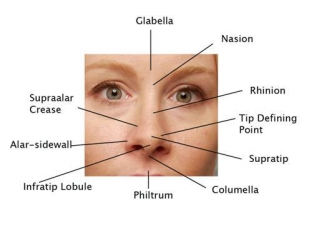Clinical analysis of the proportions of the face and nose is the first and most important step in rhinoplasty. During the initial visit of the patient to the doctor, a visual assessment of the proportions of the face and nose helps to determine how much surgery needs to be performed for each specific patient during rhinoplasty. It often happens that a patient turns to a doctor with a request to remove, for example, a hump on his nose.
As a result of a clinical analysis of facial proportions, the doctor can determine that the patient's request can only be one of the stages of the operation, since a slightly larger volume of intervention will achieve a much better aesthetic result of rhinoplasty. Therefore, knowledge of the basics of clinical analysis of facial proportions is an indispensable component of the planning and successful implementation of rhinoplasty.
Rhinoplasty planning algorithm: step-by-step instructions
There is a certain rhinoplasty planning algorithm that allows you to calculate the steps of the operation as much as possible and achieve the optimal aesthetic result in the end. Rhinoplasty planning algorithm is as follows:
- At the first consultation, all the wishes of the patient are clarified, as well as his detailed medical history (earlier operations, injuries, reactions to medications, etc.);
- With the help of rhinoscopy, tomography, X-ray examination and other instrumental diagnostic methods, all functional areas of the nose are examined;
- By means of a special technique, which will be described in more detail below, an analysis of the proportions of the face is carried out;
- An anatomically correct diagnosis is being made to the patient;
- Computer imaging in progress;
- The wishes of the patient and the option of the aesthetic result that the doctor can offer are compared and discussed;
- At the last stage, the choice of rhinoplasty technology is made.
Key points and dimensions in the analysis of facial proportions
More than 20 years ago, HS Byrd proposed a method for analyzing facial proportions, who found that the effect of rhinoplasty directly depends on the proportionality of the nose, chin and middle zone of the face. In the facial proportions analysis method according to Byrd, the proportions are determined by special points on the soft tissues of the face:
- G – glabella - a point along the midline, where the lower part of the forehead passes into the naso-frontal depression;
- R – nose root – a point along the midline of the back of the nose at the level of the folds of the upper eyelids;
- T – nose tip – point at the level of elevations of the domes of the lower lateral cartilages;
- S – stomion – the point of closure of the red border of the lips along the midline;
- Me – menton – maximum lower midpoint along the lower edge of the chin;
- AVR – the level of the base of the wings of the nose – runs perpendicular to the midline of the face;
- SR – level of corneas – defined in profile tangentially to the surface of the eyeball;
- RP – level of the root of the nose – vertical tangent line through the deepest point in the root of the nose;
- ACJ – level of the naso-buccal articulation – is carried out through the groove between the wing of the nose and the cheek;
- NLCP – level of the nose, lips and chin – is on the line from half of the ideal length of the nose through the border of the upper lip.

Based on these points, take measurements of the face, nose and chin:
- from point G to ATS – midface height (MFH);
- from ABP to Me – lower face height (LFH);
- from point R to T – nasal tip projection;
- from point S to Me – distance from stomion to menton (SMe);
- CP to RP – nasal root projection;
- from ACJ to TP – nasal tip projection;
- from the most anterior point of the chin to NLCP – chin projection.
You will be interested: "Professional secrets of rhinoplasty from Andrey Kharkov"
Important Principles of Byrd's Facial Proportions Analysis Method
Byrd's facial proportions analysis method is guided by certain consistent principles that make facial proportions analysis as useful and informative as possible:
- height of the middle face zone MFH should be equal to or somewhat less (up to 3 mm.) than the height of the lower face zone LFH;
- The ideal nose length RTi may differ from the existing nose length RT if the middle part of the face is equal to the bottom part RTi = SMe;
- ideal nasal tip projection should be 0.67 RTi;
- ideal projection of the root of the nose should be 0.28 RTi;
- The projection of the chin should be at the level of the NLCP in men and 3 mm posterior to it in women.
This method of analyzing facial proportions when planning rhinoplasty is not the only one, but is considered one of the most informative and accurate methods. Following it, the plastic surgeon will be able to achieve the optimal aesthetic result of rhinoplasty and meet the needs of the patient.









Add a comment